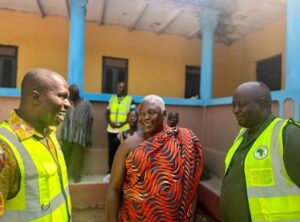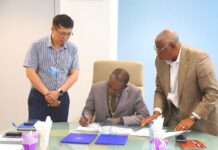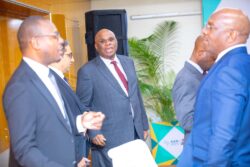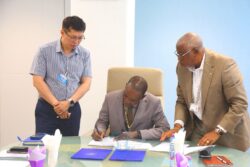By Joshua Worlasi AMLANU [email protected]
Iron ore prospects in Oti Region show promising developments, with preliminary exploration data indicating substantial commercial viability – a development that could represent a notable addition to the country’s resource portfolio.
Global iron ore demand is projected to rise by three percent annually, driven by construction and industrial needs.
The Ghana Integrated Iron and Steel Development Corporation (GIISDEC) and its technical partner, Africa Exploration and Minerals Group (AEMG), have been leading work in the Gyamurume community of Kadjebi district since 2020.
Initial findings from the exploration indicate that these iron ore deposits could be among the best in the West African sub-region. During a recent field visit, GIISDEC officials saw evidence of oxidised iron ore with high iron oxide content. According to the preliminary data, some samples contain up to 82 percent iron oxide… which translates to about 57 percent iron. On average, the oxidised ores contain around 67 percent iron oxide, or 47 percent iron.
“These are just early results, but what we are seeing is very promising,” William Okofu Darteh, Chief Executive Officer-GIISDEC, told B&FT.

(L-R) William Okofu Darteh, CEO, GIISDEC, alongside (middle) Osaberima Osei-Bonsu V, the paramount chief of the Asato Traditional Area; (right) Abudulai Batiah Santi, Deputy CEO, GIISDEC
“The preliminary results they are showing, as far as the eye can see, point to a very good grade. These numbers are based on initial tests and we still have to verify them through laboratory analysis, but they’re encouraging,” he added.
Mr. Darteh further stated that if confirmed, the grades could be higher than some deposits currently being mined in other parts of Africa. This possibility has attracted the attention of potential investors.
“Investors have been coming to us every now and then. They are interested, but we want to make sure the data is complete and accurate before we enter into any serious negotiations. We are not rushing it. We want to get it right,” he explained.
Exploration efforts so far have involved remote sensing and geophysical surveys, which helped AEMG identify 11 drilling targets from an initial 54 areas. Drilling began in mid-2024 and the team has completed eight of the planned 30 drill holes. The full drilling programme covers 15 drill lines and aims to explore a 2,500-metre area. The drilling is expected to be completed by June 2025 with a comprehensive resource estimate to follow by September.
Franklin Mace, chief geologist at AEMG, explained that the drilling has yielded consistent results.
“We are hitting banded iron formations that are averaging about 30 metres in width. What’s more we have also found serpentinite rocks, which could point to the presence of nickel. That was unexpected but could add more value to the project,” he noted.
The geological mapping has so far identified about 42,000 square metres of fully oxidised ironstones and 36,000 square metres of partially oxidised deposits. These formations extend over an 8-kilometre area, running north to south and dipping steeply to the east. Fault zones and fractures in the rocks appear to make the ore easier to access.
Over 100 rock samples have been tested by Intertek Laboratory and the University of Ghana. Results from those tests confirm that the area contains high iron content.
Prof. Frank Nyame, a lecturer at the University of Ghana and technical advisor to the project, stressed the importance of drilling to confirm the ore’s depth and consistency.
“It occurs on the surface, but we need to confirm that it occurs at depth. That’s why the drilling is important. We want to know how deep it goes and how much is really there,” he remarked.
According to Mr. Darteh, once the drilling is complete and the resource estimate is ready, GIISDEC will use the data to attract investment into the sector. The plan is to develop a full value chain for iron and steel production in Ghana, reducing the country’s dependence on gold and cocoa exports.
“This could be a game-changer. If everything goes as planned, we could have a full resource estimate by the end of September 2025. From there, we will know exactly what we have and we can move to the next stage,” he said.
The country holds approximately 1.7 billion tonnes of iron ore reserves, including the Shieni deposit (1.3 billion tonnes at 33.8 percent Fe) and Opon-Mansi (147 million tonnes at 52.5 percent Fe). A US$600million mining project at Shieni (Northern Region) will begin in late 2025, aiming to reduce annual steel imports worth US$900million. The nation plans to process iron ore domestically by 2027 to produce steel, prioritising value addition and job creation.
The local community is also paying close attention to these developments. Osaberima Osei-Bonsu V, paramount chief of Asato Traditional Area, expressed support for the project.
“This is actual mining, the first of its kind in the region. We have seen the difference between this and illegal small-scale mining. We are engaging with the companies involved and expecting that our people will benefit through jobs and other opportunities,” the traditional leader explained.
Despite some logistical challenges due to the terrain, GIISDEC says it is committed to moving forward. It is working with consultants such as SRK and state institutions like the Ghana Geological Survey Authority to ensure proper oversight. Local drilling contractor BobJosh Drilling Company is providing portable rigs that are helping the team navigate difficult terrain.
“We know there are difficulties, especially with access roads and moving equipment. But we are addressing those issues as they come,” he noted.
If the project reaches its full potential, it could form the backbone of a new industrial sector in Ghana.










